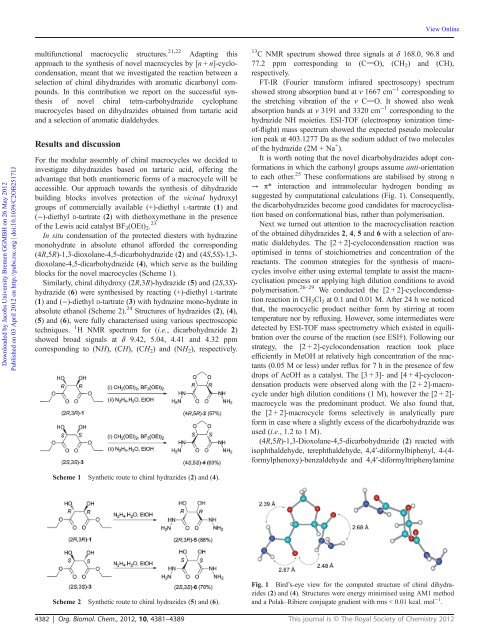The Development of Novel Antibiotics Using ... - Jacobs University
The Development of Novel Antibiotics Using ... - Jacobs University
The Development of Novel Antibiotics Using ... - Jacobs University
Create successful ePaper yourself
Turn your PDF publications into a flip-book with our unique Google optimized e-Paper software.
View Online<br />
Downloaded by <strong>Jacobs</strong> <strong>University</strong> Bremen GGMBH on 26 May 2012<br />
Published on 03 April 2012 on http://pubs.rsc.org | doi:10.1039/C2OB25171J<br />
multifunctional macrocyclic structures. 21,22 Adapting this<br />
approach to the synthesis <strong>of</strong> novel macrocycles by [n + n]-cyclocondensation,<br />
meant that we investigated the reaction between a<br />
selection <strong>of</strong> chiral dihydrazides with aromatic dicarbonyl compounds.<br />
In this contribution we report on the successful synthesis<br />
<strong>of</strong> novel chiral tetra-carbohydrazide cyclophane<br />
macrocycles based on dihydrazides obtained from tartaric acid<br />
and a selection <strong>of</strong> aromatic dialdehydes.<br />
Results and discussion<br />
For the modular assembly <strong>of</strong> chiral macrocycles we decided to<br />
investigate dihydrazides based on tartaric acid, <strong>of</strong>fering the<br />
advantage that both enantiomeric forms <strong>of</strong> a macrocycle will be<br />
accessible. Our approach towards the synthesis <strong>of</strong> dihydrazide<br />
building blocks involves protection <strong>of</strong> the vicinal hydroxyl<br />
groups <strong>of</strong> commercially available (+)-diethyl L-tartrate (1) and<br />
(−)-diethyl D-tartrate (2) with diethoxymethane in the presence<br />
<strong>of</strong> the Lewis acid catalyst BF 3 (OEt) 2 . 23<br />
In situ condensation <strong>of</strong> the protected diesters with hydrazine<br />
monohydrate in absolute ethanol afforded the corresponding<br />
(4R,5R)-1,3-dioxolane-4,5-dicarbohydrazide (2) and (4S,5S)-1,3-<br />
dioxolane-4,5-dicarbohydrazide (4), which serve as the building<br />
blocks for the novel macrocycles (Scheme 1).<br />
Similarly, chiral dihydroxy (2R,3R)-hydrazide (5) and (2S,3S)-<br />
hydrazide (6) were synthesised by reacting (+)-diethyl L-tartrate<br />
(1) and (−)-diethyl D-tartrate (3) with hydrazine mono-hydrate in<br />
absolute ethanol (Scheme 2). 24 Structures <strong>of</strong> hydrazides (2), (4),<br />
(5) and (6), were fully characterised using various spectroscopic<br />
techniques.<br />
1 H NMR spectrum for (i.e., dicarbohydrazide 2)<br />
showed broad signals at δ 9.42, 5.04, 4.41 and 4.32 ppm<br />
corresponding to (NH), (CH), (CH 2 ) and (NH 2 ), respectively.<br />
Scheme 1 Synthetic route to chiral hydrazides (2) and (4).<br />
13 C NMR spectrum showed three signals at δ 168.0, 96.8 and<br />
77.2 ppm corresponding to (CvO), (CH 2 ) and (CH),<br />
respectively.<br />
FT-IR (Fourier transform infrared spectroscopy) spectrum<br />
showed strong absorption band at ν 1667 cm −1 corresponding to<br />
the stretching vibration <strong>of</strong> the ν CvO. It showed also weak<br />
absorption bands at ν 3191 and 3320 cm −1 corresponding to the<br />
hydrazide NH moieties. ESI-TOF (electrospray ionization time<strong>of</strong>-flight)<br />
mass spectrum showed the expected pseudo molecular<br />
ion peak at 403.1277 Da as the sodium adduct <strong>of</strong> two molecules<br />
<strong>of</strong> the hydrazide (2M + Na + ).<br />
It is worth noting that the novel dicarbohydrazides adopt conformations<br />
in which the carbonyl groups assume anti-orientation<br />
to each other. 25 <strong>The</strong>se conformations are stabilised by strong n<br />
→ π* interaction and intramolecular hydrogen bonding as<br />
suggested by computational calculations (Fig. 1). Consequently,<br />
the dicarbohydrazides become good candidates for macrocyclisation<br />
based on conformational bias, rather than polymerisation.<br />
Next we turned out attention to the macrocyclisation reaction<br />
<strong>of</strong> the obtained dihydrazides 2, 4, 5 and 6 with a selection <strong>of</strong> aromatic<br />
dialdehydes. <strong>The</strong> [2 + 2]-cyclocondensation reaction was<br />
optimised in terms <strong>of</strong> stoichiometries and concentration <strong>of</strong> the<br />
reactants. <strong>The</strong> common strategies for the synthesis <strong>of</strong> macrocycles<br />
involve either using external template to assist the macrocyclisation<br />
process or applying high dilution conditions to avoid<br />
polymerisation. 26–29 We conducted the [2 + 2]-cyclocondensation<br />
reaction in CH 2 Cl 2 at 0.1 and 0.01 M. After 24 h we noticed<br />
that, the macrocyclic product neither form by stirring at room<br />
temperature nor by refluxing. However, some intermediates were<br />
detected by ESI-TOF mass spectrometry which existed in equilibration<br />
over the course <strong>of</strong> the reaction (see ESI†). Following our<br />
strategy, the [2 + 2]-cyclocondensation reaction took place<br />
efficiently in MeOH at relatively high concentration <strong>of</strong> the reactants<br />
(0.05 M or less) under reflux for 7 h in the presence <strong>of</strong> few<br />
drops <strong>of</strong> AcOH as a catalyst. <strong>The</strong> [3 + 3]- and [4 + 4]-cyclocondensation<br />
products were observed along with the [2 + 2]-macrocycle<br />
under high dilution conditions (1 M), however the [2 + 2]-<br />
macrocycle was the predominant product. We also found that,<br />
the [2 + 2]-macrocycle forms selectively in analytically pure<br />
form in case where a slightly excess <strong>of</strong> the dicarbohydrazide was<br />
used (i.e., 1.2 to 1 M).<br />
(4R,5R)-1,3-Dioxolane-4,5-dicarbohydrazide (2) reacted with<br />
isophthaldehyde, terephthaldehyde, 4,4′-diformylbiphenyl, 4-(4-<br />
formylphenoxy)-benzaldehyde and 4,4′-diformyltriphenylamine<br />
Scheme 2 Synthetic route to chiral hydrazides (5) and (6).<br />
Fig. 1 Bird’s-eye view for the computed structure <strong>of</strong> chiral dihydrazides<br />
(2) and (4). Structures were energy minimised using AM1 method<br />
and a Polak–Ribiere conjugate gradient with rms < 0.01 kcal. mol −1 .<br />
4382 | Org. Biomol. Chem., 2012, 10, 4381–4389 This journal is © <strong>The</strong> Royal Society <strong>of</strong> Chemistry 2012

















